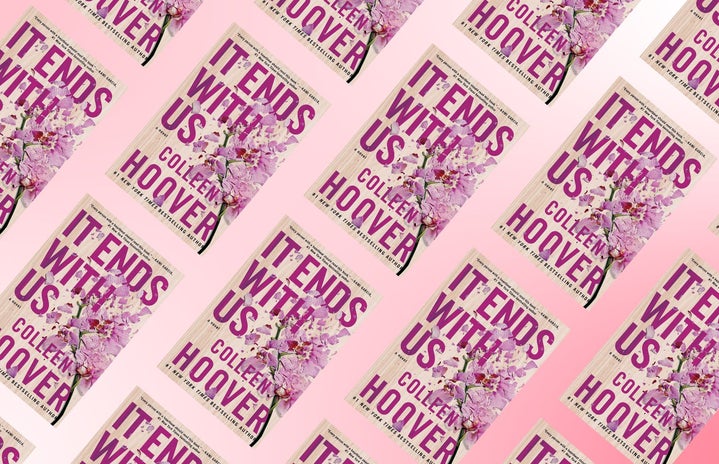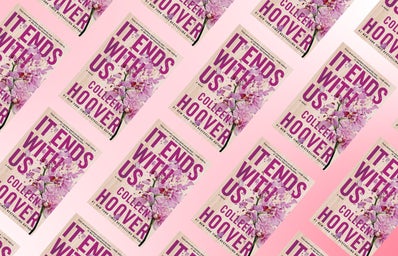Content Warning: This article may have topics that are triggering or disturbing to readers, such as domestic abuse, stalking, and assault.
Following the aftermath of Colleen Hoover’s recent controversy surrounding the It Ends With Us coloring book and her alleged affinity for romanticizing domestic abuse, the current outpouring of romantic novels that seemingly promote toxic relationships should make us reevaluate what we, as readers, are consuming and thus putting into our expectations of romance.
Colleen Hoover’s most popular book, which will soon become a feature-length film starring Blake Lively and Justin Baldoni, has as many scathing critics as it has raving fans. It Ends With Us was first published in 2016, but thanks to a viral 2021 resurgence on BookTok, a subsection of the popular media app TikTok, the novel has garnered a new crop of readers, most between the ages of 16 and 30.
It Ends With Us follows the relationship between recent college graduate, Lily Bloom, and neurosurgeon, Ryle Kincaid. Their relationship begins slow and sweet, but escalates with Ryle assaulting, manipulating, and abusing her. Domestic abuse as a plot element is nothing new. However, it’s mostly found in mysteries and thrillers, not in romance novels which tend to be books targeted at young, female audiences. Hoover, in the back blurb for the novel, describes It Ends With Us as a love triangle between the three main characters. In reality, the novel romanticizes the actions of Lily’s abuser, Ryle, while attempting to sell the book as a celebration of female survivors and those who break the cycle.
The issue with It Ends With Us isn’t that Lily maintains a life with Ryle, nor that it’s a story about domestic abuse; it focuses too much on the good aspects of Ryle, his suave, charming persona and his good looks, which seems to overshadow his very deliberate pattern of abuse. Because of this, It Ends With Us becomes less of a celebration of Lily and women as survivors and more about glorifying Ryle and abusers as ‘attractive’ male leads or romantic interests.
One such reviewer on the novel’s Goodreads page states, “I love how Lily always talks about Ryle wearing his scrubs as a doctor and having the ‘steadiest hands in Boston.’ I also love how passionate Ryle is about being a doctor and he’s so driven and goal-oriented.” While it is realistic for abusers to hide their true intentions under charming masks, it’s Hoover’s responsibility to portray abusers for what they are: bad people. Not the idea that “we’re all just people who sometimes do bad things,” which humanizes people who, quite honestly, don’t deserve the sympathy of those they have wronged.
Similarly, Hoover’s earlier work, November 9, features a romance riddled with toxic treatment of the main character and a litany of crimes that are marketed as “charming,” “steamy,” and “an unforgettable love story between a writer and his unexpected muse.” November 9 follows the story between Fallon and Ben as they meet every year on November 9 to rekindle their love. After surviving a house fire, Fallon has been left with burn scars that severely impact her self-esteem throughout the novel. Ben, the love interest, frequently makes it known to Fallon that he finds her beautiful despite her scars.
Now, this would be quite romantic if it weren’t for the fact that Ben talks over Fallon during these moments instead of allowing her to cope with what is an understandable insecurity. Furthermore, Ben frequently controls Fallon, at one point demanding that she wears an outfit he picked for her or fantasizing about “push[ing] her to the ground and hold[ing] her there until the cab drives away.” Hoover depicts these actions as a masculine man who is being protective of the woman he is madly in love with, or the effects of trauma on a person’s actions, instead of the abusive relationship that it is.
Worse than that, however, November 9 includes some chapters where consent is ambiguous or just non-existent, with one chapter even having to be written out of the book after receiving severe backlash. Early on in the book, hours after meeting each other, Ben forces Fallon to undress for him, pressing on despite her obvious discomfort and the tears in her eyes. At one point, when Fallon is unsure if she wants him to touch her body, Ben continues despite her uncertainty.
In a chapter that has been edited out of future printings of November 9, Ben assaults Fallon. There is no way to excuse it. There is no way to see it as anything other than molestation and coercion. And yet, despite Fallon repeatedly asking him to stop, the scene was written in a way that was supposed to be “steamy” instead of “creepy”. Hoover uses these scenes to set up a “love story” when in reality, it is a horror novel about one man’s persistent abuse of a woman.
A side effect of these toxic male leads is the repercussions they can have on the target audience; teenage readers. Younger audiences who see Ryle or Ben portrayed with romantic interest will grow to think of their traits, their toxicity, and their actions as what a loving relationship looks like. While older readers are still capable of falling for characters that possess these traits, they have the experience and wisdom to tell what is and isn’t a toxic relationship. Younger readers who lack the same knowledge and experience read or watch these series and idealize these characters, don’t know when or how to separate the good aspects of an abuser from their said abuse.
This is scarier to think about when, given statistics from domestic abuse service Project Opal, 40% of women ages 18 to 24 are victims of sexual assault and 43% will have experienced abuse by an intimate partner. Without properly addressing the fact that men like Ryle and Ben are not supposed to be your ideal man, adolescents and young adults who make up the target audience for these novels will come to see toxic relationships and abuse as ‘love’.
Criticism like this begs the question: is there a way to fix contemporary romance without losing the stories we love today? Absolutely. Novels like The Love Hypothesis by Ali Hazelwood or The Seven Husbands of Evelyn Hugo by Taylor Jenkins Reid manage to weave comedy, romance, drama, and spice while shying away from depicting toxicity in a romantic light. Christina Lauren’s Love and Other Words handles sexual abuse (and from the perspective of a male victim) with the proper respect and storytelling required by such a subject.
The theme of celebrating female survivors of abuse is ten-fold in Khaled Hosseini’s A Thousand Splendid Suns, a personal favorite of mine, while still maintaining an uplifting romance between well-rounded characters. It’s imperative for authors of romance to portray relationships as realistic and healthy. For books like It Ends With Us, it’s all the more important for authors to clearly show that an abuser and the toxic traits they possess shouldn’t be romanticized or glorified.
It Ends With Us should focus more on celebrating the strength of Lily, and women who survive like her, rather than focusing on romantic love. The film and future series that attempt to tackle something as heavy as domestic abuse should highlight the love survivors need to have for themselves and the people they have to protect. They should highlight the incredible strength it takes not only to escape a dangerous situation, but the strength it takes to separate the person one loves from the person who hurts them. It Ends With Us is at its best when it moves away from the love triangle and the male leads and focuses on Lily, who represents so many women who survive and live after being abused.
If you suspect that you or a loved one are a victim of domestic abuse, please visit thehotline.org or call 1-800-799-SAFE.



